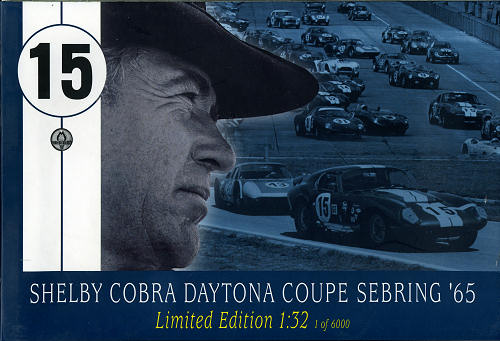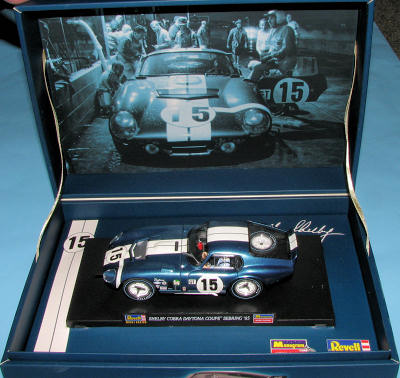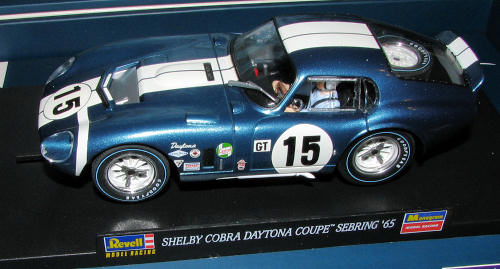
Revell-Monogram 1/32 1964 Shelby Cobra Daytona Coupe.
| KIT #: | RMX-4360 |
| PRICE: | $50.00 SRP (43.20 at GreatModels ) |
| DECALS: | N/A |
| REVIEWER: | Scott Van Aken |
| NOTES: | Ready to run Slot Car |

| HISTORY |
The Shelby Daytona (also referred to as the Shelby Daytona Cobra Coupe) was a coupé based loosely on the AC Cobra roadster. It was built for auto racing, specifically to take on Ferrari in the GT class. Just six Daytona coupes were built in 1964 and 1965, with Shelby reassigned to the Ford GT40 project after that. Pete Brock designed the car's bodywork, while Bob Negstad designed the car's suspension. Negstad also designed the chassis and suspension for the GT40.
Five Shelby Daytona cars were constructed in Italy, one car, known to collectors as CSX2287, was manufactured in the United States. Ownership of the cars was recorded for five cars, however records for the sixth car were lost in the mid-1970s. For a long time car historians and collectors feared the sixth car was lost.
In 2001 the car was discovered in a rental storage unit in California. The owner Donna O'Hara had committed suicide by burning herself alive. The car had remained undiscovered for about three decades. Due to its estimated worth of $4,000,000 the car was part of an extensive legal battle between her mother who sold the car to a collector in Pennsylvania, and a friend of Ms. O'Hara who was the recipient in her will of the contents of the storage unit. An earlier owner of the car appears to have been music producer Phil Spector who had been known to drive it on the streets of Los Angeles. Built for high-speed sprints, the cab became uncomfortably warm as the car engine heated up, among other problems. "It wasn't a street car; it was a race car," Shelby said. Still, Spector drove it on the streets, and legend is that Spector racked up so many speeding tickets, his lawyer advised him to get rid of the car before he lost his license.
The discovery of this car has been dubbed as the greatest find in the history of car collecting.
CSX2287 has been mechanically reconditioned and is on display at the Simeone Foundation Automotive Museum in Philadelphia. Jay Leno has been to the museum and video of him driving the car appears on his Web site:
| THE CAR |
 This
particular car dates back from about 2002. It was at this time that Revell
decided to revive the Monogram Racing label to start selling slot cars again. At
the time of the 2002 IPMS/USA convention, I talked with a representative of R-M
about the program. I was somewhat surprised to hear that not only was the hobby
still alive, but that there was a large European following. R-M wanted to get
into this so had developed its first new cars in decades, including the Cobra
Daytona Coupe, the Corvette Gran Sport and the 1965 Mustang fastback.
This
particular car dates back from about 2002. It was at this time that Revell
decided to revive the Monogram Racing label to start selling slot cars again. At
the time of the 2002 IPMS/USA convention, I talked with a representative of R-M
about the program. I was somewhat surprised to hear that not only was the hobby
still alive, but that there was a large European following. R-M wanted to get
into this so had developed its first new cars in decades, including the Cobra
Daytona Coupe, the Corvette Gran Sport and the 1965 Mustang fastback.
The Cobra is quite representative of the three. It has a standard 18,000 rpm Mabuchi motor in the front of the chassis driving the rear gear through a flexible extension shaft. This shaft goes through a bearing just prior to the pinion gear and keeps things aligned. The front motor seems odd to those of us who enjoyed this sport in the 1960s and 70s, but is typical of today's RTR (Ready To Run) car where the manufacturer tries to emulate the motor position in the real car. All three of the previously mentioned cars are front engine vehicles.
Also typical of today's cars, this one has a traction magnet. This device is designed to hold the car in the slot and also allows the tires that come with it, more traction on plastic track. Those of us who routinely remove these magnets (as they don't allow the car to slide) will replace the tires with silicone compounds and add weight. Revell-Monogram have designed their traction magnet to be slide back or forth about a half inch, allowing more or less tire traction.
 The car
itself is beautifully assembled and painted. The method used on modern RTR slot
cars provides a finish that few of us are able to duplicate. This particular car
is in a superb deep metallic blue with white stripes. Other details are equally
well painted. These are not done by hand, but by a machine and it is known as
Tampo Printing. You see this all the time on Hot Wheels and other die-cast cars.
The car
itself is beautifully assembled and painted. The method used on modern RTR slot
cars provides a finish that few of us are able to duplicate. This particular car
is in a superb deep metallic blue with white stripes. Other details are equally
well painted. These are not done by hand, but by a machine and it is known as
Tampo Printing. You see this all the time on Hot Wheels and other die-cast cars.
As for performance, the car is a very smooth runner. Thanks to the magnetic attraction, it is a bit slow on the start, but once underway, is a sprightly performer. The dynamic brakes on the motor are not as good as some and those who decided to remove the traction magnet will notice this right away. Removing the magnet does improve the acceleration quite a bit, though. When comparing this car with one that has been 'de-magged' (magnet removed, silicone tires and weight added), it is considerably quicker in terms of lap time. For example, on my 150 foot Scalextric Sport track, the fresh from the box car will turn laps in the 20 second bracket, while the de-magged car rarely goes any quicker than the high 23s.
| CONCLUSIONS |
Despite its vintage and the front motor position, it is very much a worthwhile car to add to one's collection. This is one of their 'limited production' cars with 6,000 made. These are getting somewhat scarce, though R-M did overproduce these and all their other early cars. The truth is that it seems a standard production run of most RTR cars is 5,000 or less. It was a learning experience for R-M and thankfully, that has allow those of us who only recently returned to the hobby, the opportunity to find some of these in new condition.
| REFERENCES |
http://en.wikipedia.org
September 2009 Thanks to
GreatModels
for the preview car. If you would like your product reviewed fairly and quickly, please
contact
me or see other details in the
Note to
Contributors.